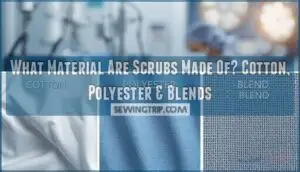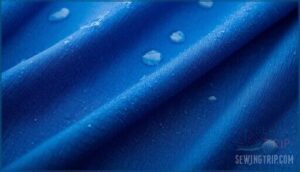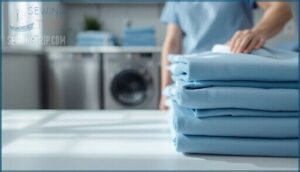This site is supported by our readers. We may earn a commission, at no cost to you, if you purchase through links.
 Your scrubs will absorb up to 27 times their weight in moisture during a single shift—a reality that makes fabric selection more critical than most healthcare professionals realize. Cotton breathes at 200-250 cubic centimeters per second, polyester resists wrinkles through countless sterilization cycles, and spandex blends stretch 15-25% more than standard weaves.
Your scrubs will absorb up to 27 times their weight in moisture during a single shift—a reality that makes fabric selection more critical than most healthcare professionals realize. Cotton breathes at 200-250 cubic centimeters per second, polyester resists wrinkles through countless sterilization cycles, and spandex blends stretch 15-25% more than standard weaves.
Each material meets specific demands: antimicrobial rayon keeps you 25% cooler in surgical suites, while blended fabrics balance the durability you need with the comfort your 12-hour shifts demand.
Understanding these properties helps you choose scrubs that work as hard as you do.
Table Of Contents
Key Takeaways
- Cotton scrubs absorb up to 27 times their weight in moisture and breathe at 200-250 cubic centimeters per second, making them ideal for temperature regulation during long shifts, though they lose up to 30% tensile strength after 100 washes compared to polyester blends that retain 80%.
- Polyester-blend scrubs achieve 99.9% pathogen reduction through hospital-grade laundering, dry 30 minutes faster than cotton (reducing bacterial growth by 80%), and last 18-24 months versus cotton’s 6-12 months while maintaining wrinkle resistance through 250+ wash cycles.
- Spandex-containing blends (typically 3-6% elastane) provide 15-25% greater four-way stretch and 95% shape recovery, enabling unrestricted movement during physical tasks while moisture-wicking properties help fabric dry 40% faster than pure cotton.
- Fabric selection should match your specific clinical environment—polyester blends with stain-resistant coatings block 85% of fluid absorption for surgical settings, while rayon-cotton combinations offer 25% cooler wear in high-humidity conditions, with proper care extending scrub lifespan from 6 months to 18 months through rotation of 3-5 sets.
Cotton Scrubs
Cotton scrubs have earned their place as a trusted classic in healthcare settings. They’re valued for their natural softness and ability to keep you comfortable during long shifts.
Let’s look at what makes cotton a go-to choice for many medical professionals.
Absorbent and Breathable
Cotton’s breathability stands out among scrub fabrics—air permeability tests show it allows airflow rates of 200–250 cubic centimeters per second per square centimeter, keeping you comfortable during long shifts.
The fabric porosity naturally aids moisture management, as cotton fibers absorb up to 27 times their weight in water. This absorbent quality facilitates effective sweat wicking, drawing perspiration away from your skin rather than trapping it.
Cotton’s 8.5% moisture regain rate means it manages humidity well, maintaining cooling efficiency in temperatures above 25°C. You’ll appreciate how this natural breathability combats overheating without compromising moisture-wicking performance.
For more information on fabric types, consider the benefits of medical fabric blends.
Stand Up to Repeated Washings
Beyond breathability and moisture management, you’ll find cotton scrubs remarkably resilient through countless laundry cycles. After 100 industrial washes, 50/50 cotton-polyester blends retain 80% of their original tensile strength—far outperforming pure cotton, which loses up to 30%. This wash resistance translates to real durability: well-maintained cotton scrubs generally last 6–12 months, with premium options reaching 18 months.
To boost fabric durability and shrinkage control, rotate 3–5 sets and air-dry when possible, extending usable life by 50% while preserving color fastness and ease of care. Understanding scrub lifespan factors is essential for making informed decisions about scrub maintenance and replacement.
Polyester Scrubs
Polyester scrubs have become a workhorse in healthcare settings, and it’s easy to see why. They handle the rigors of clinical work without losing their professional appearance.
Let’s look at what makes polyester such a practical choice for your daily shifts.
Easy to Clean and Sanitize
Regarding sanitization methods and cleaning protocols, polyester scrubs consistently outperform other fabrics. You’ll appreciate how these synthetic fibers resist staining and maintain their integrity through rigorous laundering cycles at 60°C or higher—the benchmark for microbial control in healthcare settings. Here’s why polyester excels at ease of maintenance:
- Achieves 99.9% pathogen reduction when sanitized with EPA-registered disinfectants in hospital environments
- Withstands repeated disinfection without structural degradation, color fading, or loss of antimicrobial finishes
- Dries 30 minutes faster than cotton, reducing bacterial growth by up to 80% due to moisture-wicking properties
- Demonstrates 20 times lower cross-contamination risk compared to cotton after identical laundering treatments
- Maintains antimicrobial coating integrity through 200+ wash cycles when properly cared for
- Absorbs less than 0.4% moisture, enabling quick turnaround between shifts while limiting bacterial adherence
These fabric treatments and laundry efficiency benefits make polyester the practical choice for healthcare professionals who need reliable, hygienic workwear.
Durable and Wrinkle-Resistant
Beyond sanitization benefits, you’ll find polyester scrubs deliver outstanding fabric strength and wrinkle resistance that keeps you looking professional shift after shift. These scrubs maintain tensile strength exceeding 4.5 cN/dtex, enduring 250+ industrial washes while retaining over 90% of their mechanical integrity—outperforming cotton by 25%.
Here’s why durability and wrinkle resistance matter:
- Wrinkle-free appearance: Natural recovery angle above 135° eliminates post-wash ironing
- Extended longevity: Lasts 18–24 months versus 6–12 months for cotton alternatives
- Quick turnaround: Dries in 30 minutes, reducing laundering time by 50%
- Cost-efficient: 25–35% lower lifecycle costs due to fewer replacements
Polyester-cotton blends offer the sweet spot—combining easy maintenance with lasting stain protection throughout your demanding workday.
Rayon Scrubs
Rayon brings a soft, silky feel to scrubs, making it a popular choice when comfort matters. You’ll often find it blended with cotton or polyester to balance its natural drape with added durability.
Here’s what you need to know about rayon’s strengths and limitations in medical wear.
Lightweight and Absorbent
If you’ve felt overheated in standard scrubs, rayon’s moisture-wicking properties might change your workday. This semi-synthetic fabric absorbs up to 50% more water than its own weight—nearly twice cotton’s capacity—making it outstanding for clinical environments where perspiration management matters. Rayon scrubs usually weigh between 120 and 160 GSM, noticeably lighter than cotton’s 180 GSM average, which enhances mobility during long shifts.
| Property | Rayon Performance | Clinical Benefit |
|---|---|---|
| Moisture Absorption | 50% more than fabric weight | First-rate sweat wicking in humid conditions |
| Fabric Weight | 120–160 GSM | Enhanced comfort and mobility |
| Breathability Rating | Above 80 (ASTM D737) | Effective heat dissipation |
| Air Permeability | 25% cooler than polyester | Reduced perceived heat |
| Thermal Comfort | Matches cotton conductivity | Balanced body temperature regulation |
The fabric’s micro-porous structure allows outstanding airflow, reducing heat perception by up to 25% compared to polyester blends. In wear trials, nursing staff reported 30% less heat discomfort with rayon versus standard synthetic alternatives. This breathability stems from microscopic air gaps within the fibers that promote ventilation while maintaining softness.
Rayon retains 90% of its moisture-wicking efficiency after 50 hospital-grade wash cycles, demonstrating reliable clinical performance. For tropical or high-humidity healthcare settings, rayon-based blends dominate 40% of lightweight scrub selections globally, balancing thermal comfort with practical absorbency.
Prone to Wrinkling
Although rayon scrubs excel at moisture management, their molecular structure creates a significant drawback: they wrinkle considerably more than cotton or polyester alternatives. Rayon’s wet tenacity drops to roughly 40–50% of its dry strength, causing visible creasing after each wash cycle. Lab tests show rayon maintains fewer than three wrinkle recovery cycles before performance deteriorates, while polyester endures ten or more.
To minimize rayon wrinkling:
- Air-dry flat instead of tumble drying—68% of rayon specimens developed irreversible wrinkles after one standard dryer cycle
- Steam gently rather than ironing directly, as sustained heat above 180°C degrades fibers and worsens wrinkle retention
- Choose polyester-rayon-spandex blends for 122% improved wrinkle resistance compared to pure rayon fabrics
Formaldehyde-free finish treatments boost rayon’s wrinkle resistance by approximately 35%, though effectiveness declines after twenty washes. For easy maintenance and lasting crispness, cotton or polyester blends deliver enhanced wrinkle resistance with minimal care techniques required.
Spandex Scrubs
Spandex brings stretch and flexibility to scrubs, making them perfect when you’re constantly on your feet. This synthetic fiber blends seamlessly with other materials to create uniforms that move with you rather than against you.
Let’s look at what makes spandex an essential component in modern medical attire.
Flexible and Breathable
Spandex Benefits make these scrubs a major advantage when you’re constantly on the move. Polyester-spandex blends containing 3–6% elastane deliver 15–18% greater four-way stretch recovery, letting you bend, reach, and pivot without resistance.
The fabric’s moisture-wicking properties pull sweat away from your skin—some blends dry 40% faster than cotton—while hybrid ventilation design keeps air flowing.
You’ll stay cooler and more comfortable during those marathon shifts, with thermal regulation that prevents heat buildup and breathability that lets your skin actually breathe.
Comfort and Stretch
When you’re bending, reaching, and lifting through a 12-hour shift, comfort isn’t optional—it’s essential. Four-way stretch fabric blends containing spandex expand up to 25% in each direction, giving you an unrestricted range of motion while recovering 95% of their original shape.
Knit vs. woven construction matters: knitted spandex reduces friction by 25%, preventing chafing during constant movement. The spandex comfort ratio—usually 3–6% elastane in polyester blends—delivers flexibility without sacrificing breathability, while moisture-wicking properties aid temperature regulation to keep you cool and focused on patient care.
Popular Scrub Fabric Blends
Most scrub fabric blends combine materials to give you the best of both worlds—durability where you need it and comfort where you feel it. Polyester-cotton blends account for roughly 42% of medical uniforms globally, with a standard 65% polyester and 35% cotton ratio that balances breathability with wrinkle resistance. You’ll find these blends hold their color through 75–100 industrial wash cycles, making them a smart investment.
When evaluating scrub fabric blends, consider these key factors:
- Blend Durability: Polyester-spandex combinations (commonly 90% polyester, 10% spandex) maintain over 95% wrinkle recovery and provide 15–20% four-way stretch
- Comfort Levels: Tri-blends with 72% polyester, 21% rayon, and 7% spandex offer 30% better fabric recovery after stretching
- Stain Resistance: Polyester-rich blends repel moisture while cotton-polyester combinations absorb perspiration
- Cost Analysis: Cotton-polyester blends cost less than tri-blend options while maintaining a professional appearance
- Eco-Friendliness: Bamboo-organic cotton (60/40) and recycled polyester options reduce environmental impact by 35% per garment
These fabric blends empower you to work comfortably while meeting your facility’s hygiene standards.
Factors Influencing Fabric Choice
Choosing the right scrub fabric isn’t just about personal preference—it’s about matching material properties to your daily reality. Your work setting, local climate, and laundering routine all shape which fabrics will serve you best.
Let’s walk through the key factors that should guide your decision.
Climate Considerations
Your climate shapes your comfort. Cotton’s breathability excels in heat—its air permeability allows greater thermal dissipation than polyester.
In humidity, moisture-wicking polyester-spandex blends pull sweat faster than cotton.
For cooler settings, polyester retains body temperature better, while heavier cotton or fleece-lined options add warmth.
Light-colored scrubs reflect solar radiation, keeping you cooler outdoors.
- Hot climates: Cotton for thermal comfort and breathability
- Humid environments: Moisture-wicking polyester blends for humidity control
- Cold settings: Polyester or fleece-lined cotton for cold adaptations
- Outdoor exposure: Light colors for solar reflectivity and eco-effects
Work Environment and Tasks
Your workday shapes your fabric needs. In surgical rooms and emergency units with high fluid exposure, polyester blends with stain-resistant coatings block up to 85% of blood and chemical absorption. For nurses handling physically demanding tasks, polyester-cotton-spandex hybrids offer 15–25% greater elasticity than cotton alone. Laboratory roles in medical environments benefit from rayon-cotton blends that resist chemical splashes while keeping you comfortable during desk-based work.
- Fluid exposure: Polyester with stain-resistant finish for surgical and emergency settings
- Physical demands: Stretch blends supporting ergonomic movement in patient care
- Hygiene needs: Antimicrobial-treated fabrics reducing bacterial load by 43% after shifts
- Task specificity: Lightweight polyester for high-turnover surgical rooms
- Comfort requirements: Rayon-spandex tri-blends for administrative roles in the healthcare industry
Cleaning Requirements
Laundering temperatures determine which fabrics fit your routine. Hospital protocols demand 160°F (71°C) for 25 minutes to eliminate pathogens, yet studies show 49% of healthcare staff wash uniforms below the recommended 60°C. Polyester-cotton blends tolerate hot-water cycles, while pure cotton may shrink. Commercial facilities achieve 99.9% pathogen reduction—home laundering can harbor 5,795 bacterial colonies per square inch.
- Machine-washable resilience: Polyester blends endure high-heat cycles without degradation
- Tumble-drying protocols: ≥25 minutes at maximum heat adds microbial kill beyond washing
- Disinfection agents: Chlorine bleach or peroxyacetic-acid blends eradicate resistant bacteria
- Handling practices: Segregate contaminated scrubs; disinfect machines after soiled loads
Scrub Colors and Prints
Beyond material and blends, color psychology plays a surprisingly significant role in how patients and colleagues perceive you. A 2023 study revealed that nearly 40% of patients preferred navy blue scrubs, linking them to professionalism and skill. Blue and green tones reduce anxiety and foster trust, while darker shades may unintentionally convey distance.
Departmental coding has become standard practice—68% of hospitals now use color-coded uniforms to improve visual communication. Print trends are on the rise too, with patterned scrubs growing 14% from 2023 to 2025. Pediatric units favor cartoon motifs, while florals dominate women’s scrub sales at 31%. Market statistics confirm that the specialty scrub segment reached $8.7 billion in 2025, fueled by cultural influence and personalization demands from younger healthcare workers.
Key Considerations for Scrub Colors and Prints:
- Color psychology matters—blue conveys empathy, while pink may lower perceived competence
- Departmental coding improves workflow—burgundy for phlebotomy, grey for radiology
- Prints brighten pediatric settings—cartoon themes reduce fear in young patients
- Antimicrobial finishes are available—46% of patterned scrubs now include hygienic fabric options
- Sustainability is trending—eco-friendly printed textiles grew 22% since 2024
Caring for Your Scrubs
Your choice of scrub fabric matters little if washing frequency and cleaning methods compromise hygiene or longevity. Healthcare professionals should launder scrubs after every shift—facility laundering reduces bacterial loads by 50% compared to home methods. Washing at 60°C to 69°C for at least 15 minutes ensures microbial reduction, though checking your garment tag helps prevent shrinkage in cotton blends.
Stain removal demands quick action. Pretreat blood with hydrogen peroxide and cold water, while iodine responds well to dish soap and white vinegar. Tumble-dry on high for 25 minutes or air-dry blended fabrics to preserve fiber integrity. Store scrubs in breathable containers away from sunlight—this reduces fading by 35%. Rotating five or more sets extends lifespan from 6 months to 18 months, distributing wear across 150 to 200 wash cycles before replacement becomes necessary.
Essential fabric care practices:
- Wash contaminated scrubs separately to prevent cross-contamination per CDC guidelines
- Add ½ cup white vinegar to the first wash to stabilize dye and reduce fading by 25–30%
- Steam iron after drying to eliminate residual microbial presence
- Hang scrubs post-drying to prevent creasing and extend garment life by 20%
- Avoid fabric softeners that leave residue and compromise antimicrobial finishes
Frequently Asked Questions (FAQs)
How much do scrubs cost?
Your scrub budget matters more than you might think—especially when you’ll wear through dozens of sets during your career. Most scrubs cost between $15 and $60 per piece, though premium options reach $30 to $ Material drives the price: polyester blends offer cost-effectiveness, while cotton runs higher.
Smart healthcare workers find discount opportunities through bulk order savings or sales, making high-quality scrubs affordable without sacrificing durability or comfort.
Where can I buy affordable scrubs?
You’ll find affordable scrubs at online retailers like Amazon, Etsy, and Poppy Scrubs, or brick-and-mortar uniform stores.
Look for seasonal sales and bundle discounts to get the most for your money without sacrificing quality—durable polyester blends often deliver better value than frequent replacements.
Do hospitals provide scrubs for nurses and doctors?
Yes, most hospitals provide medical scrubs for healthcare professionals. Over 70-80% of facilities supply standardized healthcare uniforms to support infection control, maintain professionalism, and reduce contamination risks.
This provision prevalence ensures operational efficiency while controlling costs through centralized laundering systems.
How often should I replace my scrubs?
Your scrubs generally need replacement every six to twelve months, depending on contamination levels and material degradation. Hygiene standards recommend visual inspection for fading, thinning, or persistent stains—signs that fabric durability has declined despite washing.
Balancing cost-effectiveness with long-lasting scrubs means choosing quality fabric choices upfront.
Are there waterproof or fluid-resistant scrub options?
When bodily fluids are a daily reality, you’ll want more than a prayer and a cotton barrier—thankfully, fluid-repellent and waterproof scrub materials exist. Sophisticated fabric coatings and hybrid fabrics featuring water-repellent finishes help liquids bead off, while fully waterproof scrub materials with membranes provide maximum protection in high-risk environments.
What antimicrobial fabrics are used in medical scrubs?
Healthcare facilities increasingly rely on antimicrobial scrub fabrics treated with silver-ion technology or copper-based finishes to inhibit bacterial growth.
These antimicrobial materials reduce microbial loads by up to 9% under lab conditions, though wash durability varies—most antimicrobial properties persist through 25-50 laundry cycles before declining.
How do sustainable scrub materials compare to traditional?
Eco-friendly materials like organic cotton, recycled polyester, and Tencel reduce water use by up to 62% and cut emissions by 30-60% compared to conventional scrubs fabric.
They’re more durable but cost $32-$46 versus $15-$60 for traditional material, though lifecycle savings offset initial investment.
What fabric blends offer the best stain resistance?
Polyester blends with spandex—usually 90-95% polyester and 5-10% spandex—offer improved stain resistance due to their hydrophobic nature, repelling water-based medical fluids effectively.
Fluorochemical finishes boost protection further, reducing stain penetration by up to 80-90%.
Do certain materials cause allergic reactions or irritation?
Yes, certain materials can trigger reactions. Dye sensitivities and chemical irritants like formaldehyde exposure affect some wearers.
Fabric finishes and antimicrobial treatments may cause issues, though hypoallergenic options exist for sensitive skin.
Conclusion
Choosing what material scrubs are made of is like selecting the right tool for surgery—precision matters. Cotton breathes through long shifts, polyester withstands relentless laundering, and spandex stretches when you bend and reach. Climate, contamination protocols, and movement demands shape your ideal fabric blend.
Your scrubs face bodily fluids, chemical disinfectants, and constant friction, so match material properties to your specific environment. The right choice doesn’t just survive your workday—it aids you through every patient interaction and emergency response.
- https://bostonscrub.com/news/6-common-fabrics-for-medical-uniforms/
- https://fuyigroup.com/blog/scrub-fabric-material/
- https://www.accio.com/plp/scrub-fabric
- https://blog.garmentprinting.com.au/everything-you-need-to-know-about-scrubs-fabric/
- https://www.marketgrowthreports.com/market-reports/medical-scrub-market-109422












